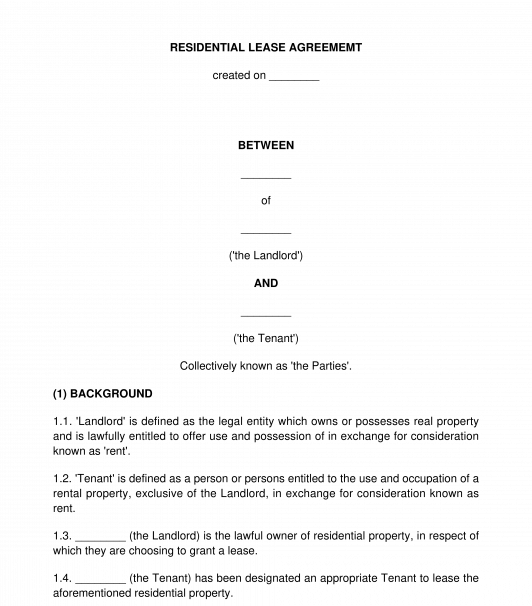 04/09/2025
04/09/2025

Answer a few questions and your document is created automatically.

Your document is ready! You will receive it in Word and PDF formats. You will be able to modify it.

 04/09/2025
04/09/2025
 Word and PDF
Word and PDF
 10 to 15 pages
10 to 15 pages



Leases at their most basic, are contracts which establish the relationship of Landlord and Tenant between two Parties and defines the legal rights and obligations which fall to both Parties in those roles.
Most importantly, a residential lease agreement affords the Tenant the right to use and possess a residential property property in exchange for periodic rent payments to the Landlord. This lease can be used in respect of any residential property, like a house, flat, apartment, condominium or any other property for which the Tenant will enjoy exclusive use and possession. This document should not be used for commercial properties or for single rooms rented out in an owner occupied house. If the user wants to rent out premises from which to conduct business, a commercial lease agreement should be sought.
This Residential Lease Agreement covers all the familiar core tenets required in a lease:
The content of a lease is largely determined by Landlord and Tenant legislation. While the corpus of positive law regulation residential leases is quite robust, certain portions of the lease can be decided wholly by the user. As such, the preferences of both parties can be included in the document and made part of the legal agreement between them. These clauses include:
How to Use the Document:
This document can be used by a commercial or private landlord, in respect of a single tenant or multiple tenants renting the same property. The user should take care fill in the form accurately. The Tenant under this lease should be an individual or individuals renting out the property to live in.
This document should ideally be written by both Landlord and Tenant in consultation with each other, to ensure they agree that all terms are fair and reasonable, and moreover are appropriate for their particular circumstances.
The document should be signed by the Landlord and Tenant, their signatures should be witnessed, and the personal information of witnesses recorded. While it is not a legal requirement for the signing of a lease to be witnessed, it is considered best practice to do so. The witness does not need to be a solicitor or notary. Anyone of the age of majority (over 18) can witness the signature, a friend, neighbour, family member or Garda are all good candidates.
This lease is a statement of the legal rights and obligations of the Parties. The undertakings agreed to herein can be legally enforced, and will form the basis of any dispute resolution service should one be required in a later phase of the relationship. As such it is important that both Parties retain hard and softs copies of this document for their personal records.
Applicable Law:
This document has been written to incorporate the law governing landlord and tenant relations and property leasing in Ireland. Specifically: The Residential Tenancies (No. 2) Act 2021, the Residential Tenancies (Amendment) Act 2019, these statutes operate to amend the Residential Tenancies Act 2004, the Property Services (Regulation) Act 2011 and (Standards for Rented Houses) Regulations 2019 .
How to modify the template:
You fill out a form. The document is created before your eyes as you respond to the questions.
At the end, you receive it in Word and PDF formats. You can modify it and reuse it.
Residential Lease Agreement - sample template
Country: Ireland